Charles E W Bean, Diaries, AWM38 3DRL 606/227/1 - Folder - Part 16
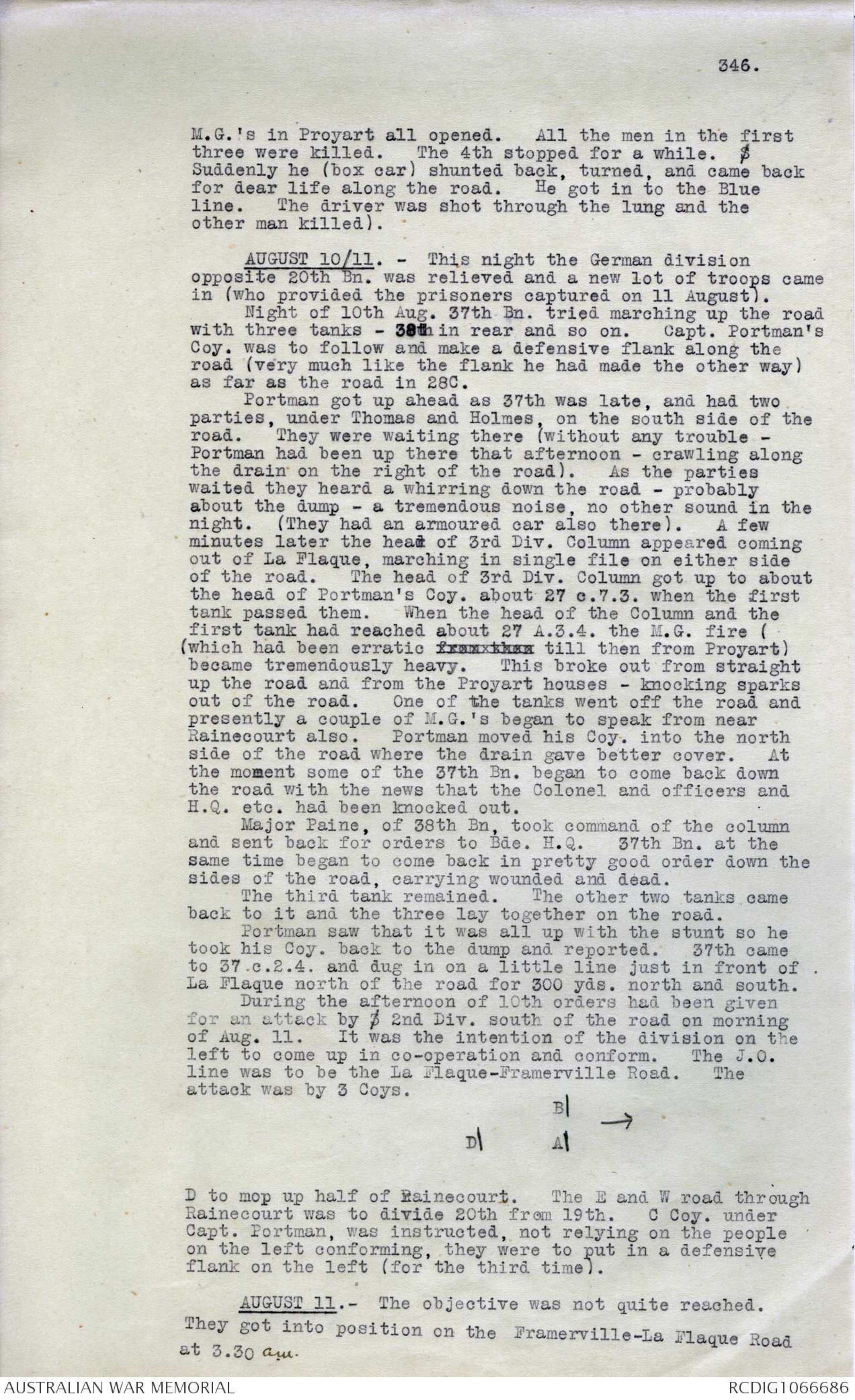
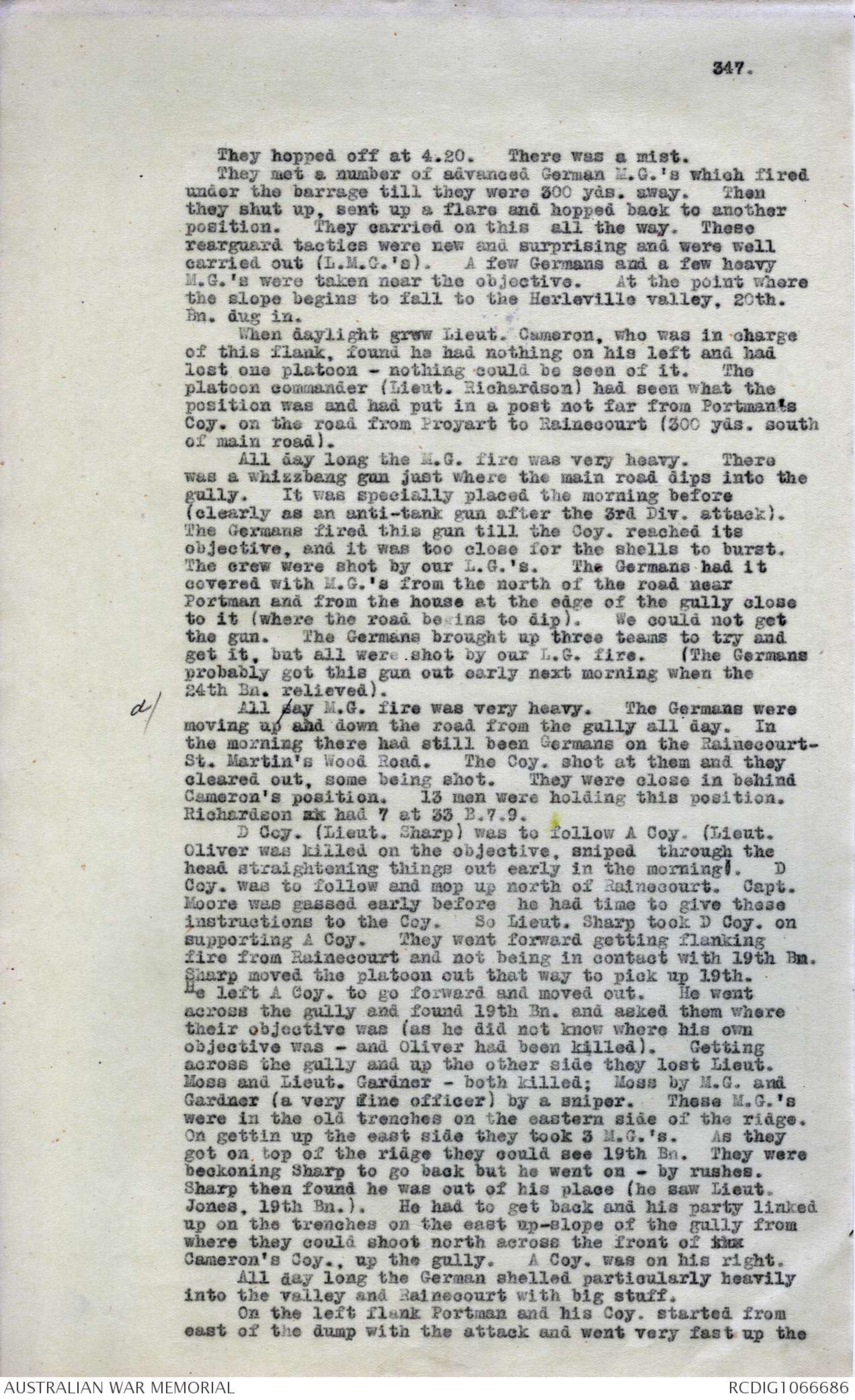
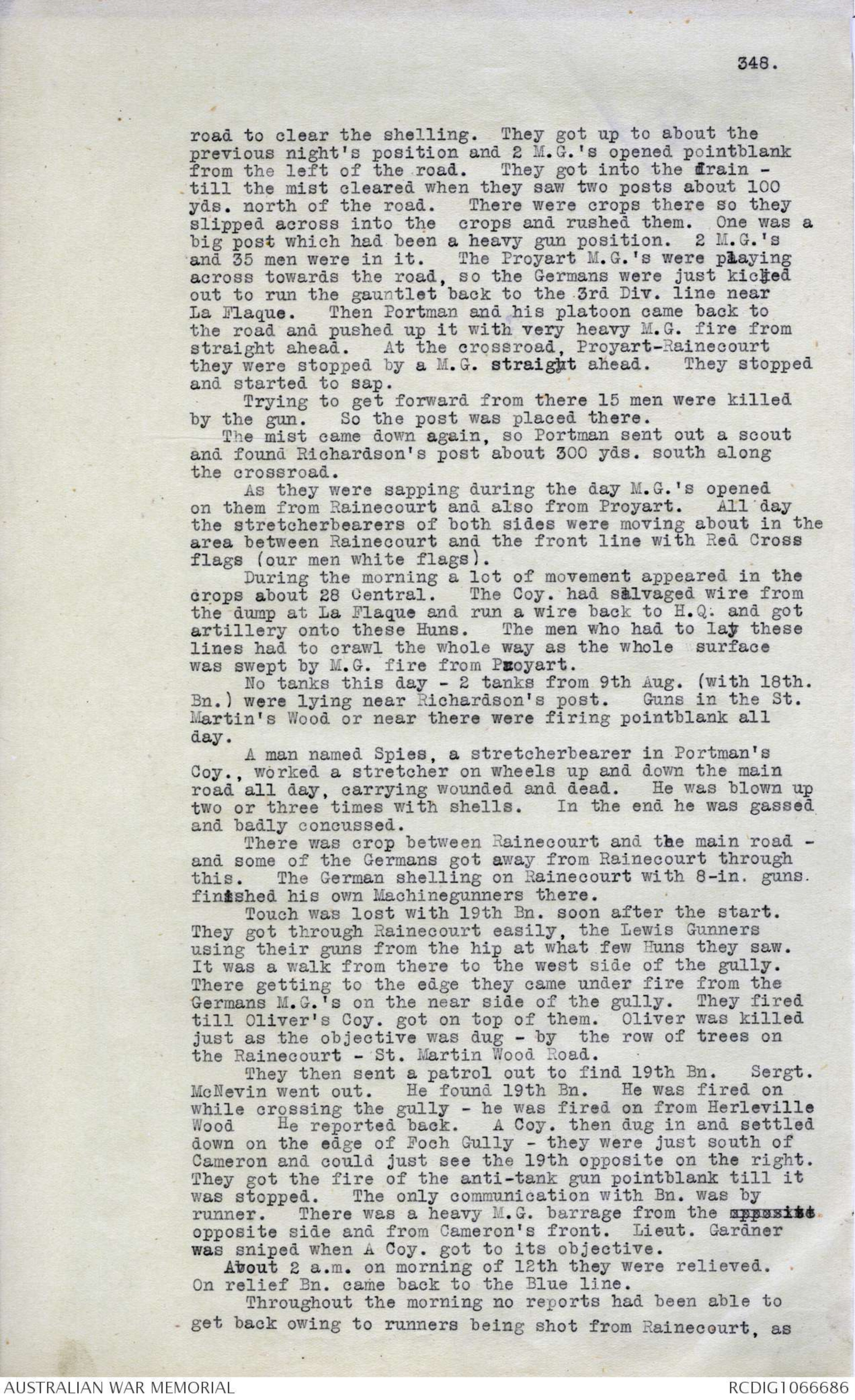
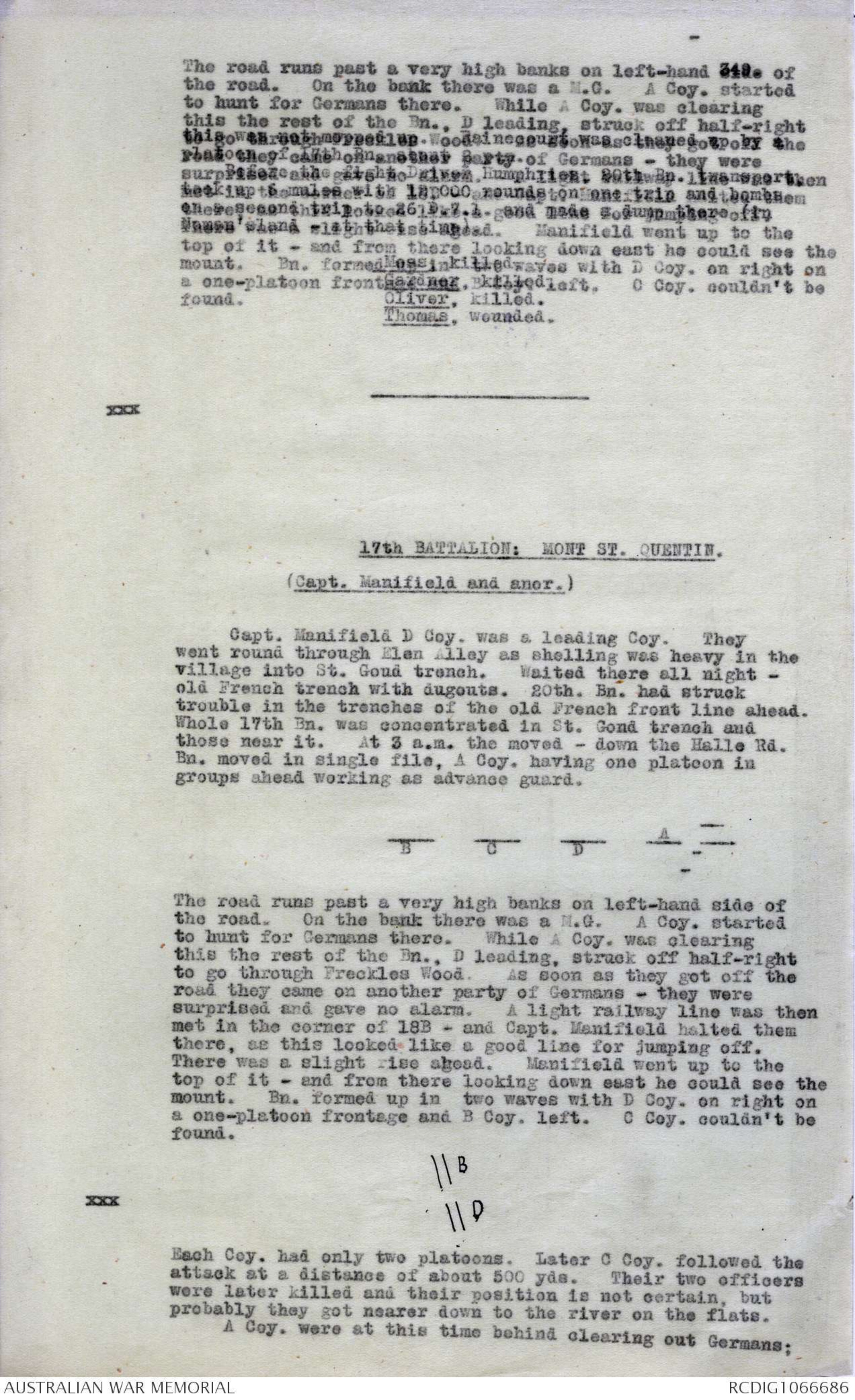
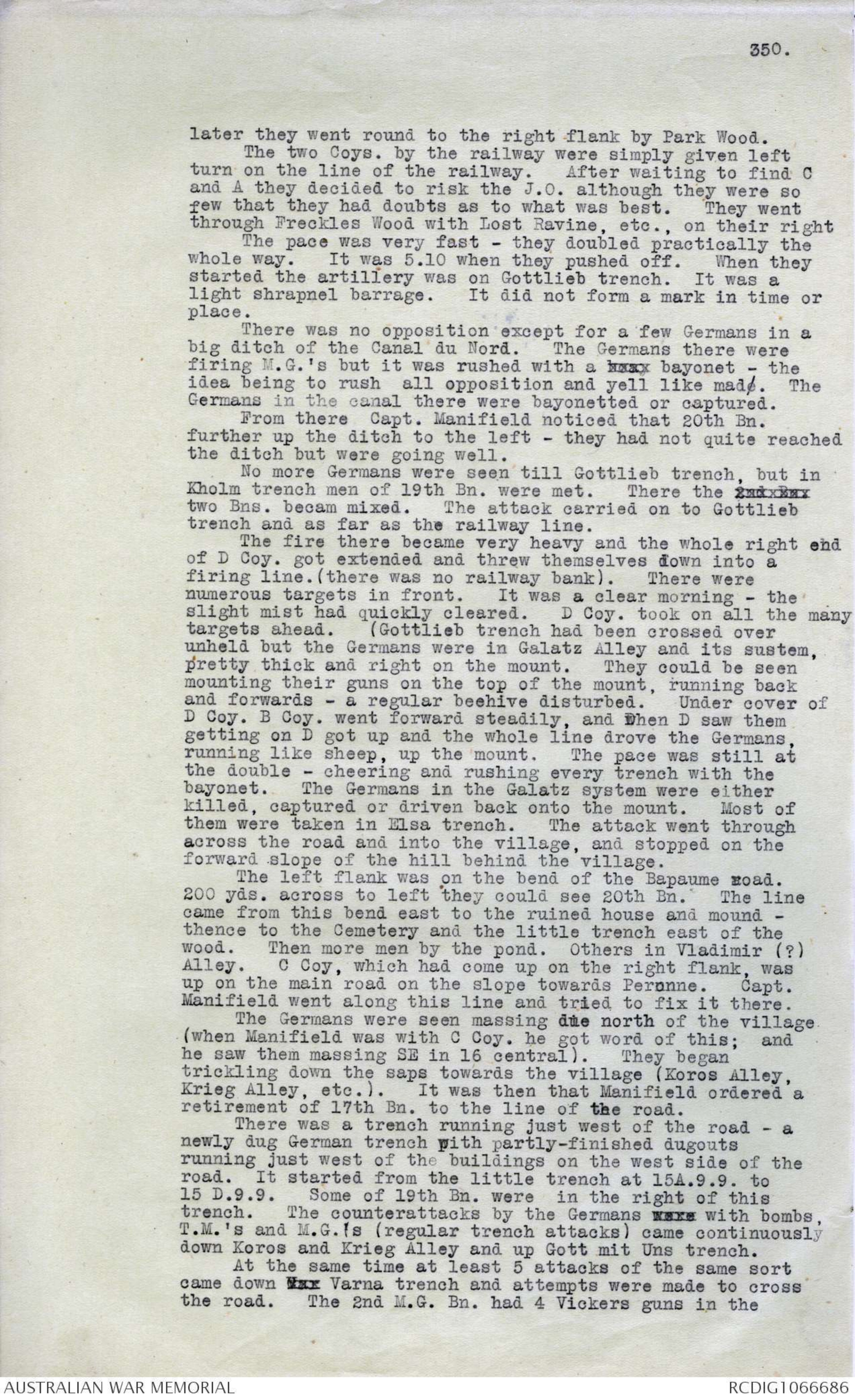
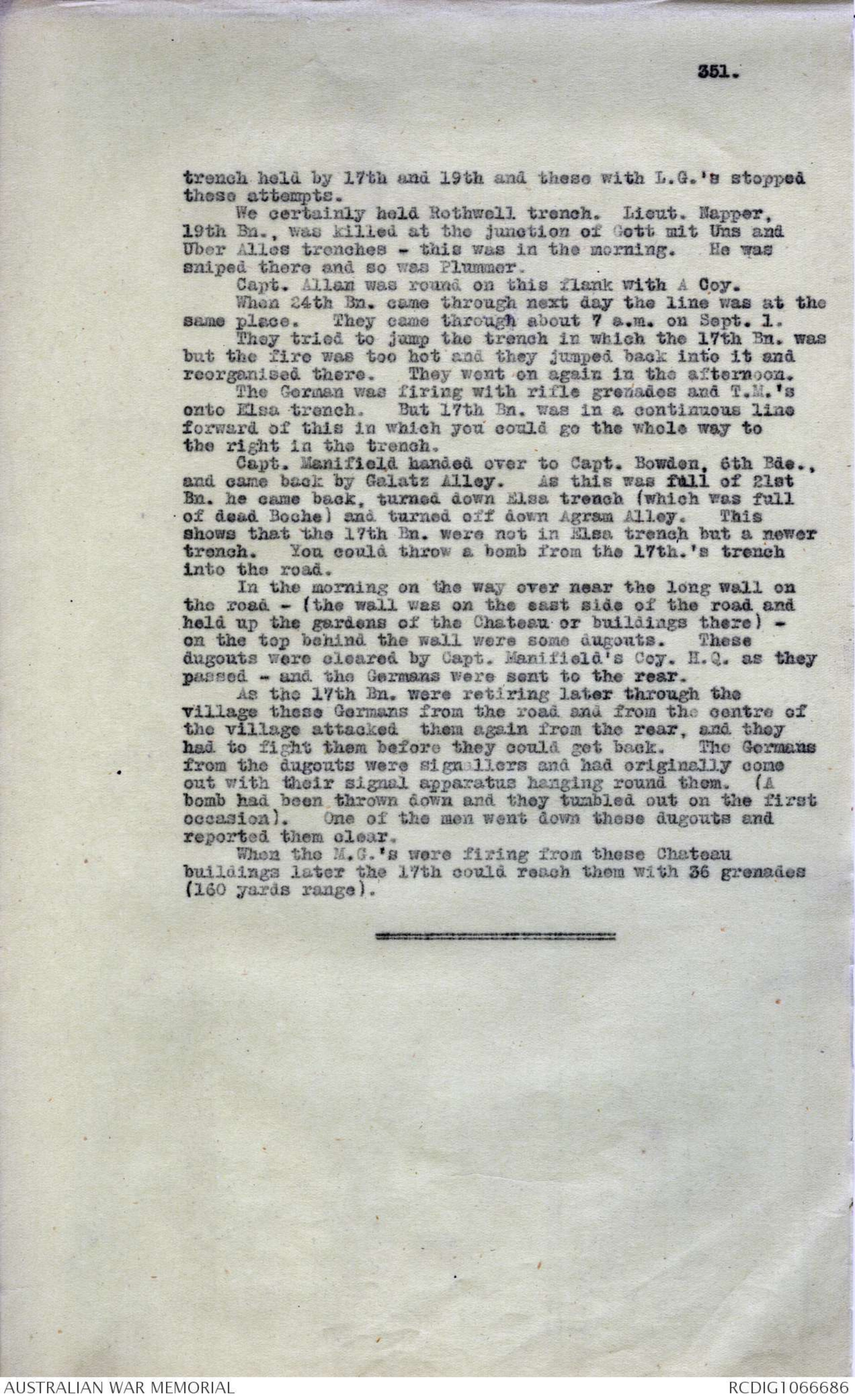
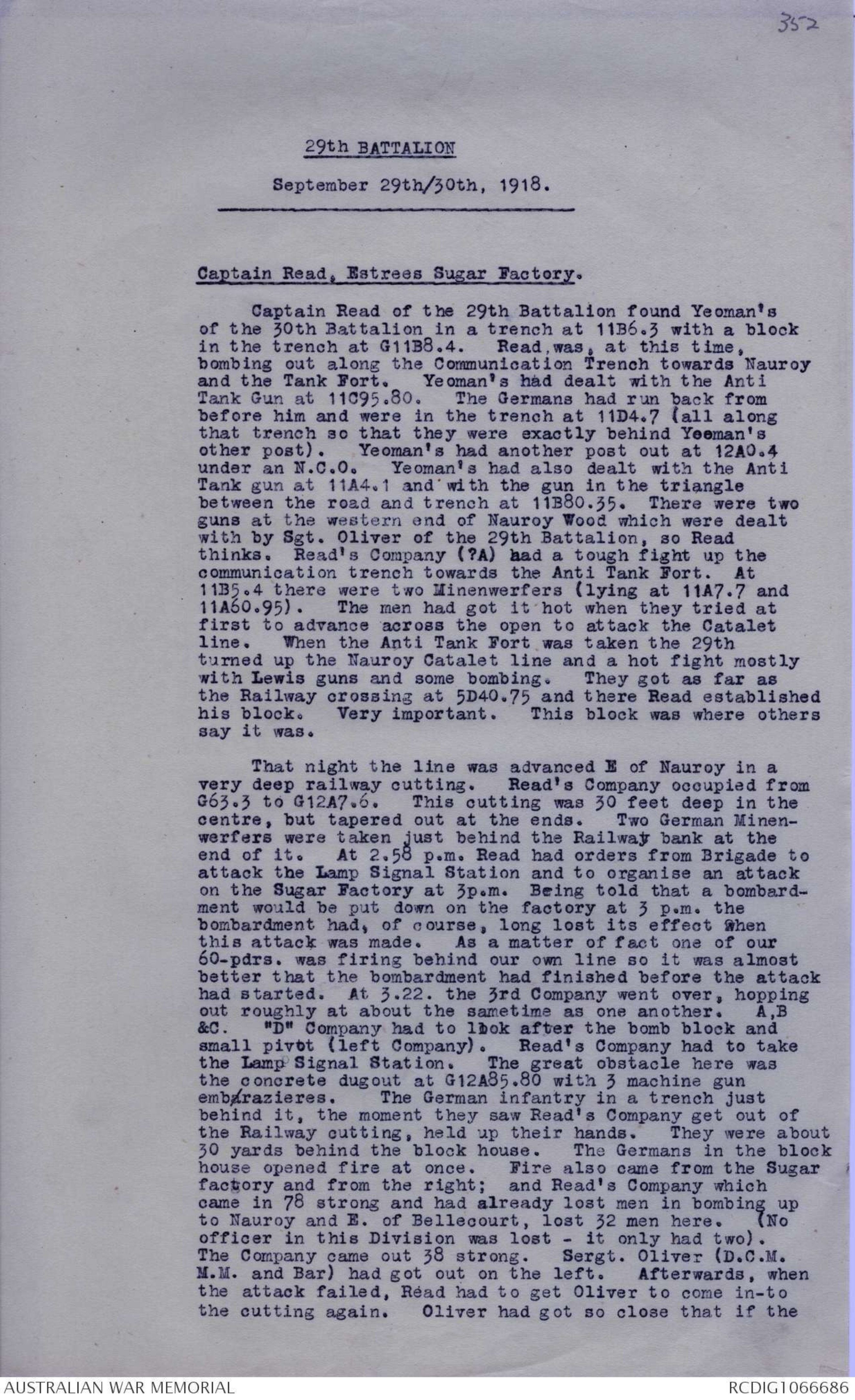
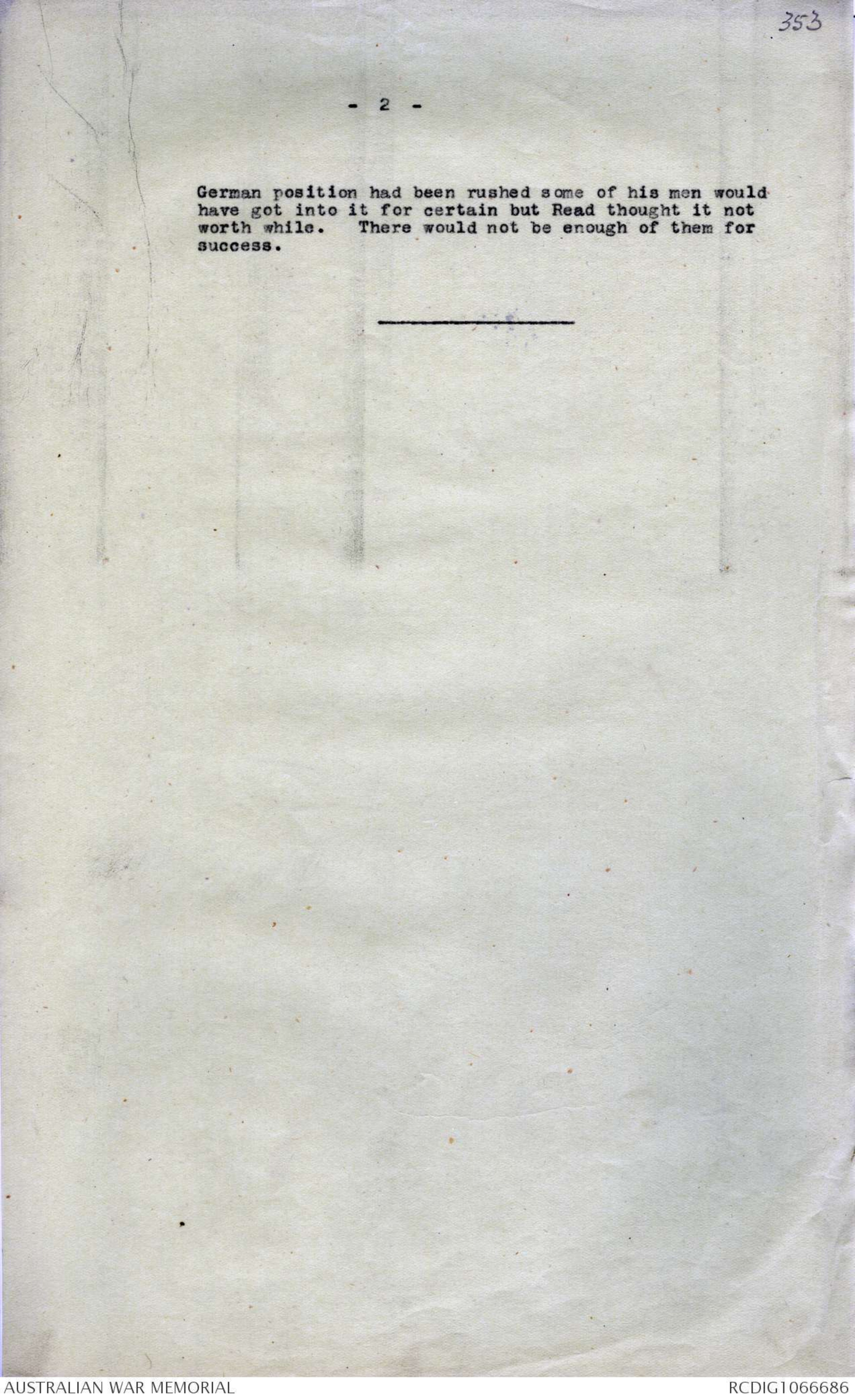
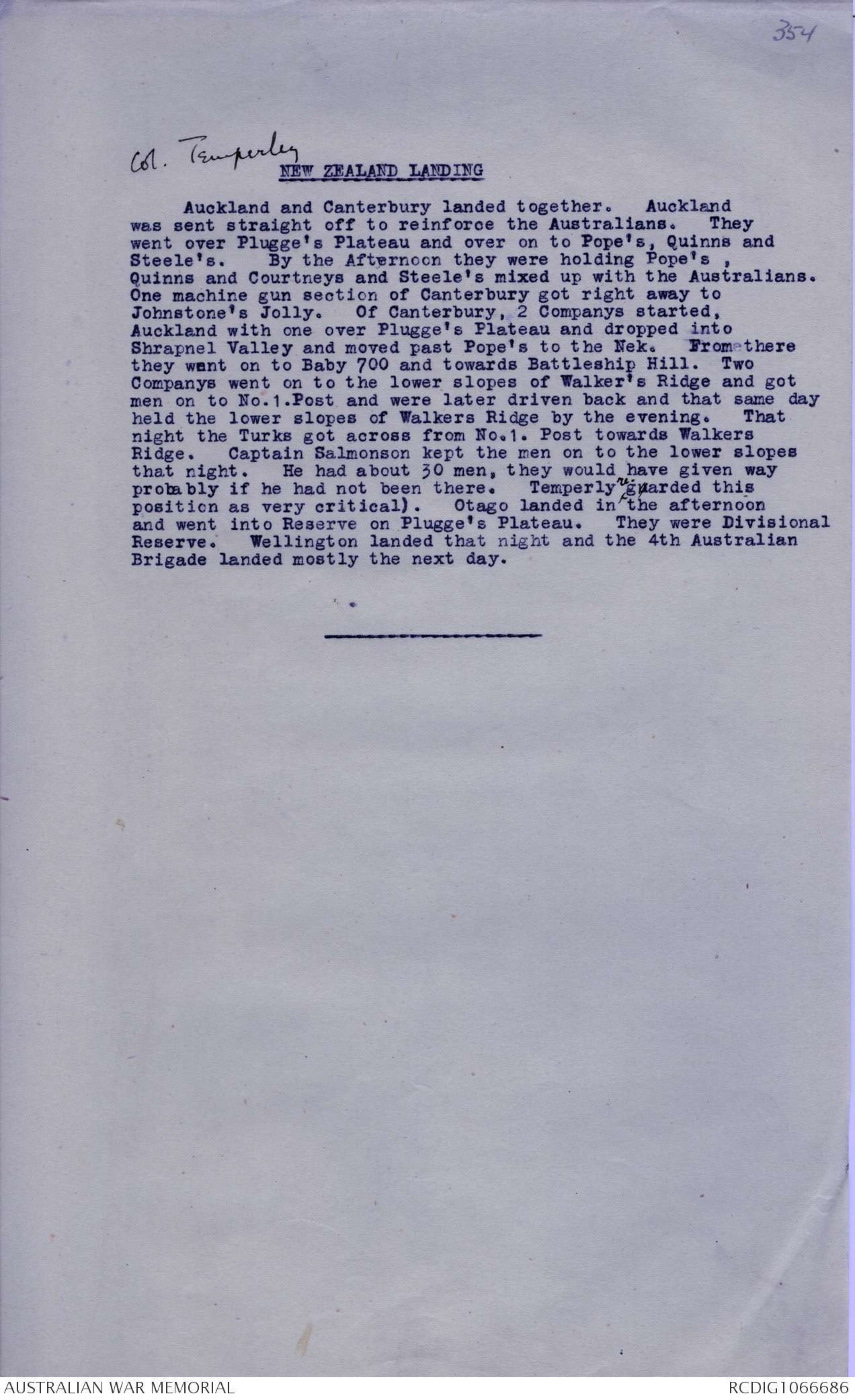
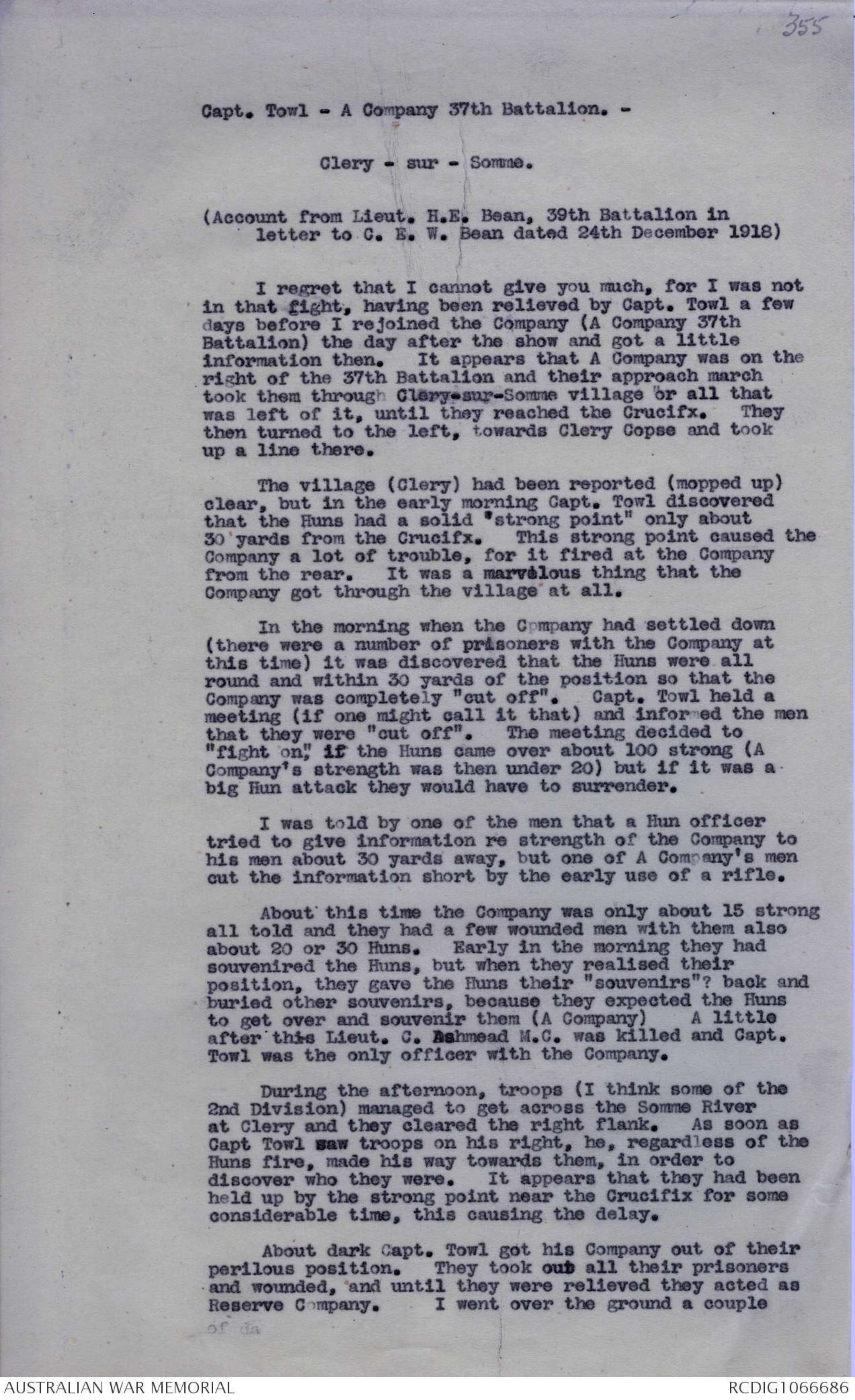
346.
M.G.'s (Machine Guns) in Proyart all opened. All the men in the first
three were killed. The 4th stopped for a while. S
Suddenly he (box car) shunted back, turned, and came back
for dear life along the road. He got in to the Blue
line. The driver was shot through the lung and the
other man killed).
AUGUST 10/11. - This night the German division
opposite 20th Bn. was relieved and a new lot of troops came
in (who provided the prisoners captured on 11 August).
Night of 10th Aug. 37th Bn. tried marching up the road
with three tanks - 38th in rear and so on. Capt. Portman's
Coy, was to follow and make a defensive flank along the
road (very much like the flank he had made the other way)
as far as the road in 28C.
Portman got up ahead as 37th was late, and had two
parties, under Thomas and Holmes, on the south side of the
road. They were waiting there (without any trouble -
Portman had been up there that afternoon - crawling along
the drain on the right of the road). As the parties
waited they heard a whirring down the road - probably
about the dump - a tremendous noise, no other sound in the
night. (They had an armoured car also there). A few
minutes later the head of 3rd Div. Column appeared coming
out of La Flaque, marching in single file on either side
of the road. The head of 3rd Div. Column got up to about
the head of Portman's Coy. about 27 c.7.3. when the first
tank passed them. When the head of the Column and the
first tank had reached about 27 A.3.4. the M.G. fire (
(which had been erratic from then till then from Proyart)
became tremendously heavy. This broke out from straight
up the road and from the Proyart houses - knocking sparks
out of the road. One of the tanks went off the road and
presently a couple of M.G.'s began to speak from near
Rainecourt also. Portman moved his Coy. into the north
side of the road where the drain gave better cover. At
the moment some of the 37th Bn. began to come back down
the road with the news that the Colonel and officers and
H.Q. etc. had been knocked out.
Major Paine, of 38th Bn, took command of the column
and sent back for orders to Bde. H.Q. 37th Bn. at the
same time began to come back in pretty good order down the
sides of the road, carrying wounded and dead.
The third tank remained. The other two tanks came
back to it and the three lay together on the road.
Portman saw that it was all up with the stunt so he
took his Coy. back to the dump and reported. 37th came
to 37.c.2.4. and dug in on a little line just in front of
La Flaque north of the road for 300 yds. north and south.
During the afternoon of 10th orders had been given
for an attack by 3 2nd Div. south of the road on morning
of Aug. 11. It was the intention of the division on the
left to come up in co-operation and conform. The J.0.
line was to be the La Flaque-Framerville Road. The
attack was by 3 Coys.
Diagram - see original document
D to mop up half of Rainecourt. The E and W road through
Rainecourt was to divide 20th from 19th. C Coy. under
Capt. Portman, was instructed, not relying on the people
on the left conforming, they were to put in a defensive
flank on the left (for the third time).
AUGUST 11.- The objective was not quite reached.
They got into position on the Framerville-La Flaque Road
at 3.30 a.m.
347.
They hopped off at 4.20. There was a mist.
They met a number of advanced German M.G.'s which fired
under the barrage till they were 300 yds. away. Then
they shut up, sent up a flare and hopped back to another
position. They carried on this all the way. These
rearguard tactics were new and surprising and were well
carried out (L.M.G.'s). A few Germans and a few heavy
M.G.'s were taken near the objective. At the point where
the slope begins to fall to the Herleville valley, 20th.
Bn. dug in.
When daylight grew Lieut. Cameron, who was in charge
of this flank, found he had nothing on his left and had
lost one platoon - nothing could be seen of it. The
platoon commander (Lieut. Richardson) had seen what the
position was and had put in a post not far from Portman's
Coy. on the road from Proyart to Rainecourt (300 yds. south
of main road).
All day long the M.G. fire was very heavy. There
was a whizzbang gun just where the main road dips into the
gully. It was specially placed the morning before
(clearly as an anti-tank gun after the 3rd Div. attack).
The Germans fired this gun till the Coy. reached its
objective, and it was too close for the shells to burst.
The crew were shot by our L.G.'s. The Germans had it
covered with M.G.'s from the north of the road near
Portman and from the house at the edge of the gully close
to it (where the road begins to dip). We could not get
the gun. The Germans brought up three teams to try and
get it, but all were shot by our L.G. fire. (The Germans
probably got this gun out early next morning when the
24th Bn. relieved).
[*d*] All say M.G. fire was very heavy. The Germans were
moving up and down the road from the gully all day. In
the morning there had still been Germans on the Rainecourt-
St. Martin's Wood Road. The Coy. shot at them and they
cleared out, some being shot. They were close in behind
Cameron's position. 13 men were holding this position.
Richardson xk had 7 at 33 B.7.9.
D Coy. (Lieut. Sharp) was to follow A Coy. (Lieut.
Oliver was killed on the objective, sniped through the
head straightening things out early in the morning). D
Coy, was to follow and mop up north of Rainecourt. Capt
Moore was gassed early before he had time to give these
instructions to the Coy. So Lieut. Sharp took D Coy. on
supporting A Coy. They went forward getting flanking
fire from Rainecourt and not being in contact with 19th Bn.
Sharp moved the platoon out that way to pick up 19th.
He left A Coy. to go forward and moved out. He went
across the gully and found 19th Bn. and asked them where
their objective was (as he did not know where his own
objective was - and Oliver had been killed). Getting
across the gully and up the other side they lost Lieut.
Moss and Lieut. Gardner - both killed; Moss by M.G. and
Gardner (a very fine officer) by a sniper. These M.G.'s
were in the old trenches on the eastern side of the ridge.
On gettin up the east side they took 3 M.G.'s. As they
got on top of the ridge they could see 19th Bn. They were
beckoning Sharp to go back but he went on - by rushes.
Sharp then found he was out of his place (he saw Lieut.
Jones, 19th Bn.). He had to get back and his party linked
up on the trenches on the east up-slope of the gully from
where they could shoot north across the front of the
Cameron's Coy., up the gully. A Coy. was on his right.
All day long the German shelled particularly heavily
into the valley and Rainecourt with big stuff.
On the left flank Portman and his Coy. started from
east of the dump with the attack and went very fast up the
348.
road to clear the shelling. They got up to about the
previous night's position and 2 M.G.'s opened pointblank
from the left of the road. They got into the drain -
till the mist cleared when they saw two posts about 100
yds. north of the road. There were crops there so they
slipped across into the crops and rushed them. One was a
big post which had been a heavy gun position. 2 M.G.'s
and 35 men were in it. The Proyart M.G.'s were playing
across towards the road, so the Germans were just kicked
out to run the gauntlet back to the 3rd Div. line near
La Flaque. Then Portman and his platoon came back to
the road and pushed up it with very heavy M.G. fire from
straight ahead. At the crossroad, Proyart-Rainecourt
they were stopped by a M.G. straight ahead. They stopped
and started to sap.
Trying to get forward from there 15 men were killed
by the gun. So the post was placed there.
The mist came down again, so Portman sent out a scout
and found Richardson's post about 300 yds. south along
the crossroad.
As they were sapping during the day M.G.'s opened
on them from Rainecourt and also from Proyart. All day
the stretcherbearers of both sides were moving about in the
area between Rainecourt and the front line with Red Cross
flags (our men white flags).
During the morning a lot of movement appeared in the
crops about 28 Central. The Coy. had salvaged wire from
the dump at La Flaque and run a wire back to H.Q. and got
artillery onto these Huns. The men who had to lay these
lines had to crawl the whole way as the whole surface
was swept by M.G. fire from Proyart.
No tanks this day - 2 tanks from 9th Aug. (with 18th.
Bn.) were lying near Richardson's post. Guns in the St.
Martin's Wood or near there were firing pointblank all
day.
A man named Spies, a stretcherbearer in Portman's
Coy., worked a stretcher on wheels up and down the main
road all day, carrying wounded and dead. He was blown up
two or three times with shells. In the end he was gassed
and badly concussed.
There was crop between Rainecourt and the main road -
and some of the Germans got away from Rainecourt through
this. The German shelling on Rainecourt with 8-in. guns.
finished his own Machinegunners there.
Touch was lost with 19th Bn. soon after the start.
They got through Rainecourt easily, the Lewis Gunners
using their guns from the hip at what few Huns they saw.
It was a walk from there to the west side of the gully.
There getting to the edge they came under fire from the
Germans M.G.'s on the near side of the gully. They fired
till Oliver's Coy. got on top of them. Oliver was killed
just as the objective was dug - by the row of trees on
the Rainecourt - St. Martin Wood Road.
They then sent a patrol out to find 19th Bn. Sergt.
McNevin went out. He found 19th Bn. He was fired on
while crossing the gully - he was fired on from Herleville
Wood He reported back. A Coy. then dug in and settled
down on the edge of Foch Gully - they were just south of
Cameron and could just see the 19th opposite on the right.
They got the fire of the anti-tank gun pointblank till it
was stopped. The only communication with Bn. was by
runner. There was a heavy M.G. barrage from the opposite
opposite side and from Cameron's front. Lieut. Gardner
was sniped when A Coy. got to its objective.
About 2 a.m. on morning of 12th they were relieved.
On relief Bn. came back to the Blue line.
Throughout the morning no reports had been able to
get back owing to runners being shot from Rainecourt, as
349
The road runs past a very high banks on left-hand side of
the road. On the bank there was a M.G. A Coy. started
to hunt for Germans there. While A Coy, was clearing
this the rest of the Bn., D leading, struck off half-right
this was not mopping up. Rainecourt was cleaned up by the
platoon they came on another party of Germans - they were
surprised at the fight given. Humphries, 20th Bn. line support then
took up 6 mules with 12,000 rounds on one trip and bombs
on second trip to 26 D.7.1 and made a dump there (in
Noman's land - at that time). Manifield went up to the
top of it - and from there looking down east he could see the
mount. Bn. formed up in two waves with D Coy. on right on
a one-platoon front and B Coy. left. C Coy. couldn't be found.
found.
Moss. killed
Gardener. killed
Oliver. killed
Thomas. wounded.
xxx __________________________
17th BATTALION: MONT ST. OUENTIN.
(Capt. Manifield and anor.)
Capt. Manifield D Coy, was a leading Coy. They
went round through Elen Alley as shelling was heavy in the
village into St. Goud trench. Waited there all night -
old French trench with dugouts. 20th. Bn. had struck
trouble in the trenches of the old French front line ahead.
Whole 17th Bn. was concentrated in St. Gond trench and
those near it. At 3 a.m. the moved - down the Halle Rd.
Bn. moved in single file, A Coy. having one platoon in
groups ahead working as advance guard.
Diagram - see original document
The road runs past a very high banks on left-hand side of
the road. On the bank there was a M.G. A Coy. started
to hunt for Germans there. While A Coy. was clearing
this the rest of the Bn., D leading, struck off half-right
to go through Freckles Wood. As soon as they got off the
road they came on another party of Germans - they were
surprised and gave no alarm. A light railway line was then
met in the corner of 18B - and Capt. Manifield halted them
there, as this looked like a good line for jumping off.
There was a slight rise ahead. Manifield went up to the
top of it - and from there looking down east he could see the
mount. Bn. formed up in two waves with D Coy. on right on
a one-platoon frontage and B Coy. left. C Coy. couldn't be
found.
xxx Diagram - see original document
Each Coy. had only two platoons. Later C Coy. followed the
attack at a distance of about 500 yds. Their two officers
were later killed and their position is not certain, but
probably they got nearer down to the river on the flats.
A Coy, were at this time behind clearing out Germans;
350.
later they went round to the right flank by Park Wood.
The two Coys. by the railway were simply given left
turn on the line of the railway. After waiting to find C
and A they decided to risk the J.O. although they were so
few that they had doubts as to what was best. They went
through Freckles Wood with Lost Ravine, etc., on their right
The pace was very fast - they doubled practically the
whole way. It was 5.10 when they pushed off. When they
started the artillery was on Gottlieb trench. It was a
light shrapnel barrage. It did not form a mark in time or
place.
There was no opposition except for a few Germans in a
big ditch of the Canal du Nord. The Germans there were
firing M.G.'s but it was rushed with a heay bayonet - the
idea being to rush all opposition and yell like made. The
Germans in the canal there were bayonetted or captured.
From there Capt. Manifield noticed that 20th Bn.
further up the ditch to the left - they had not quite reached
the ditch but were going well.
No more Germans were seen till Gottlieb trench, but in
Kholm trench men of 19th Bn. were met. There the 2nd Bn
two Bns. becam mixed. The attack carried on to Gottlieb
trench and as far as the railway line.
The fire there became very heavy and the whole right end
of D Coy. got extended and threw themselves down into a
firing line. (there was no railway bank). There were
numerous targets in front. It was a clear morning - the
slight mist had quickly cleared. D Coy. took on all the many
targets ahead. (Gottlieb trench had been crossed over
unheld but the Germans were in Galatz Alley and its sustem,
pretty thick and right on the mount. They could be seen
mounting their guns on the top of the mount, running back
and forwards - a regular beehive disturbed. Under cover of
D Coy. B Coy, went forward steadily, and when D saw them
getting on D got up and the whole line drove the Germans,
running like sheep, up the mount. The pace was still at
the double - cheering and rushing every trench with the
bayonet. The Germans in the Galatz system were either
killed, captured or driven back onto the mount. Most of
them were taken in Elsa trench. The attack went through
across the road and into the village, and stopped on the
forward slope of the hill behind the village.
The left flank was on the bend of the Bapaume road.
200 yds. across to left they could see 20th Bn. The line
came from this bend east to the ruined house and mound -
thence to the Cemetery and the little trench east of the
wood. Then more men by the pond. Others in Vladimir (?)
Alley. C Coy, which had come up on the right flank, was
up on the main road on the slope towards Pernnne. Capt.
Manifield went along this line and tried to fix it there.
The Germans were seen massing due north of the village
(when Manifield was with C Coy. he got word of this; and
he saw them massing SE in 16 central). They began
trickling down the saps towards the village (Koros Alley,
Krieg Alley, etc.). It was then that Manifield ordered a
retirement of 17th Bn. to the line of the road.
There was a trench running just west of the road - a
newly dug German trench with partly-finished dugouts
running just west of the buildings on the west side of the
road. It started from the little trench at 15A.9.9. to
15 D.9.9. Some of 19th Bn. were in the right of this
trench. The counterattacks by the Germans were with bombs,
T.M.'s and M.G.'s (regular trench attacks) came continuously
down Koros and Krieg Alley and up Gott mit Uns trench.
At the same time at least 5 attacks of the same sort
came down Var Varna trench and attempts were made to cross
the road. The 2nd M.G. Bn. had 4 Vickers guns in the
351.
trench held by 17th and 19th and these with L.G.'s stopped
these attempts.
We certainly held Rothwell trench. Lieut. Napper,
19th Bn., was killed at the junction of Gott mit Uns and
Uber Alles trenches - this was in the morning. He was
sniped there and so was Plummer.
Capt. Allan was round on this flank with A Coy.
When 24th Bn. came through next day the line was at the
same place. They came through about 7 a.m. on Sept. 1.
They tried to jump the trench in which the 17th Bn. was
but the fire was too hot and they jumped back into it and
rcorganised there. They went on again in the afternoon.
The German was firing with rifle grenades and T.M.'s
onto Elsa trench. But 17th Bn. was in a continuous line
forward of this in which you could go the whole way to
the right in the trench.
Capt. Manifield handed over to Capt. Bowden, 6th Bde.,
and came back by Galatz Alley. As this was full of 21st
Bn. he came back, turned down Elsa trench (which was full
of dead Boche) and turned off down Agram Alley. This
shows that the 17th Bn. were not in Elsa trench but a newer
trench. You could throw a bomb from the 17th.'s trench
into the road.
In the morning on the way over near the long wall on
the road - (the wall was on the east side of the road and
held up the gardens of the Chateau or buildings there) -
on the top bohind the wall were some dugouts. These
dugouts were cleared by Capt. Manifield's Coy. H.Q. as they
passed - and the Germans were sent to the rear.
As the 17th Bn. were retiring later through the
village these Germans from the road and from the centre of
the village attacked them again from the rear, and they
had to fight them before they could get back. The Germans
from the dugouts were signallers and had originally come
out with their signal apparatus hanging round them. (A
bomb had been thrown down and they tumbled out on the first
occasion). One of the men went down these dugouts and
reported them clear.
When the M.G.'s were firing from these Chateau
buildings later the 17th could reach them with 36 grenades
(160 yards range).
______________________
352
29th BATTALION
September 29th/30th, 1918.
______________________________
Captain Read, Estrees Sugar Factory.
Captain Read of the 29th Battalion found Yeoman's
of the 30th Battalion in a trench at 11B6.3 with a block
in the trench at G11B8.4. Read, was, at this time,
bombing out along the Communication Trench towards Nauroy
and the Tank Fort. Yeoman's had dealt with the Anti
Tank Gun at 11C95.80. The Germans had run back from
before him and were in the trench at 11D4.7 (all along
that trench so that they were exactly behind Yeoman's
other post). Yeoman's had another post out at 12A0.4
under an N.C.O. Yeoman's had also dealt with the Anti
Tank gun at 11A4.1 and with the gun in the triangle
between the road and trench at 11B80.35. There were two
guns at the western end of Nauroy Wood which were dealt
with by Sgt. Oliver of the 29th Battalion, so Read
thinks. Read's Company (?A) had a tough fight up the
communication trench towards the Anti Tank Fort. At
11B5.4 there were two Minenwerfers (lying at 11A7.7 and
11A60.95). The men had got it hot when they tried at
first to advance across the open to attack the Catalet
line. When the Anti Tank Fort, was taken the 29th
turned up the Nauroy Catalet line and a hot fight mostly
with Lewis guns and some bombing. They got as far as
the Railway crossing at 5D40.75 and there Read established
his block. Very important. This block was where others
say it was.
That night the line was advanced E of Nauroy in a
very deep railway cutting. Read's Company occupied from
G63.3 to G12A7.6. This cutting was 30 feet deep in the
centre, but tapered out at the ends. Two German Minenwerfers
were taken just behind the Railway bank at the
end of it. At 2.58 p.m. Read had orders from Brigade to
attack the Lamp Signal Station and to organise an attack
on the Sugar Factory at 3p.m. Being told that a bombardment
would be put down on the factory at 3 p.m. the
bombardment had, of course, long lost its effect when
this attack was made. As a matter of fact one of our
60-pdrs, was firing behind our own line so it was almost
better that the bombardment had finished before the attack
had started. At 3.22. the 3rd Company went over, hopping
out roughly at about the sametime as one another. A,B
&C. "D" Company had to look after the bomb block and
small pivot (left Company). Read's Company had to take
the Lamp Signal Station. The great obstacle here was
the concrete dugout at G12A85.80 with 3 machine gun
embarazieres. The German infantry in a trench just
behind it, the moment they saw Read's Company get out of
the Railway cutting, held up their hands. They were about
30 yards behind the block house. The Germans in the block
house opened fire at once. Fire also came from the Sugar
factory and from the right; and Read's Company which
came in 78 strong and had already lost men in bombing up
to Nauroy and E. of Bellecourt, lost 32 men here. (No
officer in this Division was lost - it only had two).
The Company came out 38 strong. Sergt. Oliver (D.C.M.
M.M. and Bar) had got out on the left. Afterwards, when
the attack failed, Read had to get Oliver to come in-to
the cutting again. Oliver had got so close that if the
353
- 2 -
German position had been rushed some of his men would
have got into it for certain but Read thought it not
worth while. There would not be enough of them for
success.
_______________
354
Col. Temperley
NEW ZEALAND LANDING
Auckland and Canterbury landed together. Auckland
was sent straight off to reinforce the Australians. They
went over Plugge's Plateau and over on to Pope's, Quinns and
Steele's. By the Afternoon they were holding Pope's
Quinns and Courtneys and Steele's mixed up with the Australians.
One machine gun section of Canterbury got right away to
Johnstone's Jolly. Of Canterbury, 2 Companys started,
Auckland with one over Plugge's Plateau and dropped into
Shrapnel Valley and moved past Pope's to the Nek. From there
they want on to Baby 700 and towards Battleship Hill. Two
Companys went on to the lower slopes of Walker's Ridge and got
men on to No. 1. Post and were later driven back and that same day
held the lower slopes of Walkers Ridge by the evening. That
night the Turks got across from No.1. Post towards Walkers
Ridge. Captain Salmonson kept the men on to the lower slopes
that night. He had about 30 men, they would have given way
probably if he had not been there. Temperly ^reguarded this
position as very critical). Otago landed in the afternoon
and went into Reserve on Plugge's Plateau. They were Divisional
Reserve. Wellington landed that night and the 4th Australian
Brigade landed mostly the next day.
__________________________
355
Capt. Towl - A Company 37th Battalion. -
Clery - sur - Somme.
(Account from Lieut. H.E. Bean, 39th Battalion in
letter to C. E. W. Bean dated 24th December 1918)
I regret that I cannot give you much, for I was not
in that fight, having been relieved by Capt. Towl a few
days before I rejoined the Company (A Company 37th
Battalion) the day after the show and got a little
information then. It appears that A Company was on the
right of the 37th Battalion and their approach march
took them through Clery-sur-Somme village or all that
was left of it, until they reached the Crucifx. They
then turned to the left, towards Clery Copse and took
up a line there.
The village (Clery) had been reported (mopped up)
clear, but in the early morning Capt. Towl discovered
that the Huns had a solid "strong point" only about
30 yards from the Crucifx. This strong point caused the
Company a lot of trouble, for it fired at the Company
from the rear. It was a marvelous thing that the
Company got through the village at all.
In the morning when the Company had settled down
(there were a number of prisoners with the Company at
this time) it was discovered that the Huns were all
round and within 30 yards of the position so that the
Company was completely "cut off". Capt. Towl held a
meeting (if one might call it that) and informed the men
that they were "cut off". The meeting decided to
"fight on," if the Huns came over about 100 strong (A
Company's strength was then under 20) but if it was a
big Hun attack they would have to surrender.
I was told by one of the men that a Hun officer
tried to give information re strength of the Company to
his men about 30 yards away, but one of A Company's men
cut the information short by the early use of a rifle.
About this time the Company was only about 15 strong
all told and they had a few wounded men with them also
about 20 or 30 Huns. Early in the morning they had
souvenired the Huns, but when they realised their
position, they gave the Huns their "souvenirs"? back and
buried other souvenirs, because they expected the Huns
to get over and souvenir them (A Company) A little
after this Lieut. C. Ashmead M.C. was killed and Capt.
Towl was the only officer with the Company.
During the afternoon, troops (I think some of the
2nd Division) managed to get across the Somme River
at Clery and they cleared the right flank. As soon as
Capt Towl saw troops on his right, he, regardless of the
Huns fire, made his way towards them, in order to
discover who they were. It appears that they had been
held up by the strong point near the Crucifix for some
considerable time, this causing the delay.
About dark Capt. Towl got his Company out of their
perilous position. They took out all their prisoners
and wounded, and until they were relieved they acted as
Reserve Company. I went over the ground a couple
 Marisa Bortolotto
Marisa BortolottoThis transcription item is now locked to you for editing. To release the lock either Save your changes or Cancel.
This lock will be automatically released after 60 minutes of inactivity.